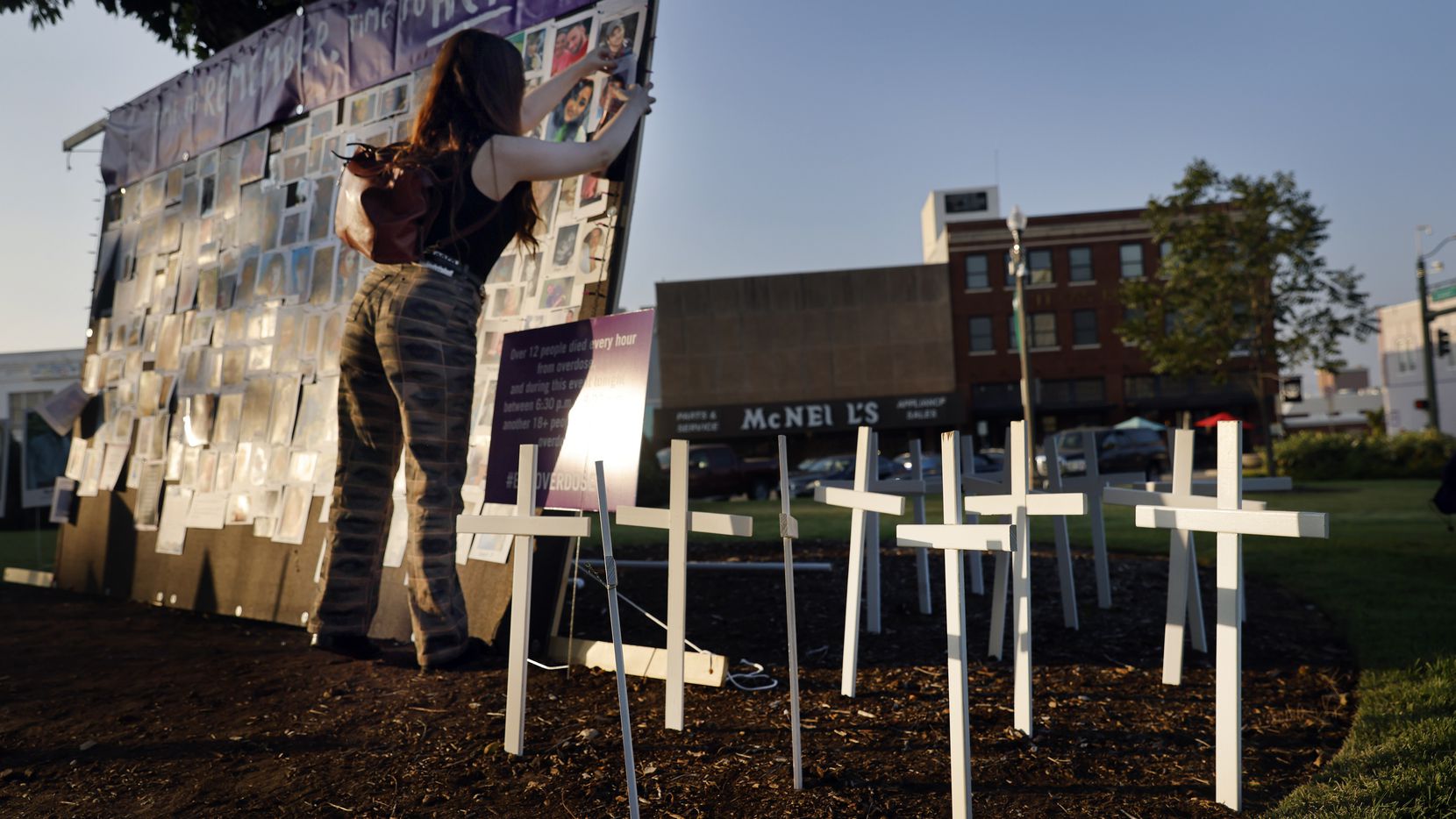This story is part of The Dallas Morning News monthlong series on how fentanyl has affected our community.
A Plano cheerleader. A 21-year-old Dallas Army veteran. A Carrollton eighth-grader. A Frisco grad working two jobs. A young Fort Worth man who was proud to be a mama’s boy.
They are among the more than 1,100 North Texans who have died since 2021 from the deadliest drug threat in American history — fentanyl.
Incredibly potent and easy to get, the synthetic opioid has overtaken heroin as the drug most frequently involved in overdose deaths in the United States. It is linked to more fatalities of Americans under 50 than any other cause of death, including heart disease, cancer and suicide.
In Texas, an average of five people died from the drug every day in 2022. A string of overdoses among school kids and young adults has left the state scrambling for solutions amid mounting pressure from families who have lost loved ones.
The highly addictive painkiller — used legally in medical settings for traumatic injuries, egg retrievals and colonoscopies — has gripped a new generation looking to self-medicate or experiment with drugs. It hides in counterfeit pills that look exactly like those prescribed for pain.
Fentanyl is cheaper to manufacture, easier to traffic and more potent than other opioids, driving illicit drug makers to use it deceptively in place of other substances. Just 2 milligrams of fentanyl, the equivalent of 10 to 15 grains of table salt, can be deadly, according to the Drug Enforcement Administration.
Many of the drug’s victims never knew they were taking it. They thought they were popping a Percocet to numb back pain or a Xanax to quell anxiety but instead ingested fentanyl, a drug 50 times stronger than heroin and 100 times stronger than morphine. For many who survive their first brush with fentanyl, the opioid becomes their drug of choice because of its low cost and fast high.
How we got here
Since its conception in Belgium in 1959, fentanyl has become one of the most useful opioids for pain management in hospitals because of its fast-acting abilities.
U.S. drug regulators were initially slow to approve it. They green-lighted fentanyl in 1968 but only in combination with another medication that curbed some of its effects after doctors warned its strength made it ripe for abuse.
Four years later, the Food and Drug Administration approved fentanyl on its own. Misuse and overdoses soon followed, but they were few and far between.
By the turn of the millennium, a focus on patients’ pain spiraled into a glut of pills — the first wave of the U.S. opioid epidemic. Across the nation, Americans fell into addiction as drugs such as OxyContin were dished out generously for bad shoulders, root canals and migraines.
The federal government eventually cracked down on unscrupulous prescriptions, which invited the illegal drug market to fill the void with heroin and methamphetamine.
The illicit use of fentanyl began its climb in 2011. It was a cost-effective additive used by illegal drug makers to amp up other drugs and keep people wanting more.
Cartels in Mexico are primarily responsible for making most of the fentanyl pills being trafficked in America today, according to U.S. authorities. The cartels obtain the precursor chemicals used to produce the raw fentanyl powder — or sometimes the powder itself — from clandestine labs in China.
What started as a slow stream of illicit fentanyl became “a flood” by 2016, according to Dr. Tom Frieden, then-director of the Centers for Disease Control and Prevention.
In 2021, authorities warned of a dramatic increase in the lethality and availability of counterfeit prescription pills laced with fentanyl. Last year, DEA Administrator Anne Milgram called the opioid the single-deadliest drug threat the nation has ever faced.
“Fentanyl is everywhere,” Milgram said. “From large metropolitan areas to rural America, no community is safe from this poison.”
Almost all fake pills today contain only fentanyl, along with inert agents such as Vitamin C, caffeine or acetaminophen, the DEA has found.
Fentanyl’s victims are more often young to middle-aged, and deaths among children 14 and younger are increasing more quickly than any other age group, according to a report from the nonprofit Families Against Fentanyl.
“We have not seen any drug screen positive for any opioid other than fentanyl since 2021,” Dr. David Atkinson, a pediatric psychiatrist at Children’s Health, said in an interview with The Dallas Morning News.
As head of the hospital’s outpatient program for substance use and mental health treatment, Atkinson works at the intersection of fentanyl and children ages 13 to 18.
“Everything they are taking that they think is Vicodin or Percocet or OxyContin — all of it ends up being fentanyl.”
Some kids who take fentanyl never make it to a treatment program like the one at Children’s, Atkinson said.
“They die on their first use.”
Fentanyl comes to Texas
The grim rise in fentanyl deaths in Texas is apparent in the steep trend line on the state’s new dashboard, which is updated quarterly.
In 2019, fentanyl accounted for 317 deaths — 11.5% of all drug fatalities in the state. The numbers have grown steadily since. Last year’s 2,161 fentanyl deaths accounted for 45% of all drug fatalities. Through the end of June 2023, 540 deaths have been reported. This number is expected to rise because toxicology reports lag deaths by several months.
In response to the increase in deaths, Gov. Greg Abbott ramped up his anti-fentanyl efforts in August 2022 with the launch of his “One Pill Kills” campaign. He designated fentanyl one of his top priorities in this year’s legislative session, and lawmakers responded with a handful of bills.
Among them were bills establishing October as Fentanyl Poisoning Awareness Month, requiring middle and high schools to educate students on the dangers of fentanyl, and getting naloxone onto school and university campuses.
The most controversial of the bills, all signed into law by Abbott, is one that allows manufacturers and distributors of illegal and deadly fentanyl to be prosecuted for murder. The law went into effect Friday.
Critics say it could discourage loved ones or friends from calling authorities during an emergency because of fear of being criminally charged.
Another proposed change to Texas law — decriminalizing fentanyl test strips — didn’t make it out of the Legislature. The strips, which are considered drug paraphernalia in Texas, can detect the presence of the deadly opioid in other drugs and could prevent unsuspecting users from taking a counterfeit prescription.
Fentanyl has killed at least 240 North Texans this year. The majority of local victims have been 15 to 44 and white or Hispanic, according to state health department data from the last five years obtained by The News.
Four Carrollton-Farmers Branch students died and at least seven others were hospitalized in a string of overdoses in the last year. The most recent victim, a 15-year-old at Newman Smith High School, died in June.
Federal prosecutors have charged 10 defendants in the Carrollton deaths; five have pleaded guilty.
The DEA’s Dallas Field Division seized 300 kilograms, or about 660 pounds, of fentanyl in the fiscal year ending Sept. 30, 2022. That’s the equivalent of 2 million fake pills. Through the first three quarters of this year, 6% more fentanyl has been confiscated than the previous 12 months.
“Fentanyl’s delivery method is disarming,” Eduardo Chávez, special agent in charge of the DEA’s Dallas operation, said in an interview with The News. “Never before has there been an illicit drug that looks so familiar to us, that looked like a pharmaceutical drug.”
Chávez said his agents have yet to see the latest threat menacing many parts of the country — fentanyl mixed with xylazine.
“There’s been a few cases in East Texas, but nothing here — yet,” he said.
Doctors remain divided on whether the presence of this tranquilizer, used by veterinarians on horses and other large animals, makes a deadlier fentanyl pill, but they agree xylazine creates its own set of breathing problems and causes heart rates to drop.
Chávez pointed to a 2018 fentanyl case as his marker for the drug becoming a consistent threat in North Texas. The case developed out of a police chase that ended with confiscation of fentanyl pills, empty pharmaceutical-style bottles and fake labels from the trunk of a car.
The incident provided evidence that helped the DEA bust a pill operation in southern Dallas. Inside the home, agents found 300,000 deadly pills made to look like prescription medicine.
Before that, Chávez said, federal agents had for several years confiscated fentanyl passing through Dallas for sale in other parts of the country, but it was rarely marketed here.
Today, he said, “Fentanyl is the most deadly drug we know in North Texas, and it’s not somebody else’s problem.
“It’s not just happening ‘over there,’ wherever that ‘there’ may be. Fentanyl is everywhere.”
The drug, with its deceptive disguises, has shattered families across North Texas. Lilia Astudillo will never again bear-hug her 14-year-old son. Zayden Williams will never again laugh at his older brother’s goofy antics. Stephanie Vaughn will never again take a picture of her daughter on the first day of school.
“You can’t hide,” Vaughn said. “Anyone who thinks their kid isn’t susceptible has blinders on.”
As part of this month’s Deadly Fake project, The News will detail the stories of some of these families and others who have been impacted by fentanyl in North Texas.



